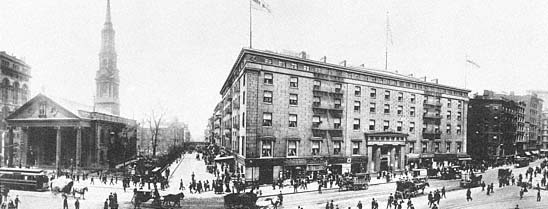Early Developments:
The First-Class Hotel
The architectural development of the palace hotel was a story of ever-increasing specialization and separation. Wealthy members of the business elite, very much like
the fictional Spraggs, began to live permanently in hotels in about 1800, at the same time that the best hotel buildings began to be more than mere inns. American inns and taverns in the 1700s looked much like large single-family houses. Not until the late 1700s did grand architecture or elegance grace travelers' lodgings in Europe or America; simultaneously, the word hotel (in English) came to denote inns of a superior kind.[29] Between 1790 and 1820, associations of wealthy businessmen in the United States improved on English hotels by building structures with elaborate public spaces as well as a totally new scale of 70 to 300 very simple sleeping rooms. In Boston's 300-room Exchange Hotel, opened in 1809, putting numbers on the room doors was enough of a novelty to merit mention in travelers' accounts.[30] After 1820, American hotel investors outbuilt structures like the Exchange Hotel and essentially invented the world model for the large modern hotel. Simultaneously, they added a new level of luxury and a more private life in personal rooms. Providing each room with an individual washbowl, water pitcher, and soap at first distinguished these hotels. Significantly, it was in this generation of expensive hotels that permanent guests first gained a high profile. English travelers in America frequently complained that they could not get the good rooms they wanted because the best accommodations were occupied by permanent boarders—judges, lawyers, merchants, and others who brought their families to live in the hotel.[31]
Most American inns and hotels before the 1820s had mixed people from somewhat disparate backgrounds, to the chagrin of those European travelers who were both fastidious and wealthy. The opening of Boston's Tremont House in 1829 signaled new and more socially restrictive management ideas for the United States. The Tremont had only one room rate—a high one for its time—of $2 a day for room and board. For permanent residents, it offered elegantly furnished private parlors attached to suites of rooms. As part of their rent, Tremont tenants enjoyed lavish hotel service that included the first bellboys and the first hotel dining room in the United States to feature French cuisine. The managers and the architect of the Tremont also analyzed functions that had been crowded into earlier hotel rotundas and separated them into four spaces—lobby, desk or office, baggage room, and bar. The Tremont was thus one of the first hotels where guests went into a lobby

Figure 2.7
An 1895 view of the Astor House in New York, built in 1836. This panoramic view shows the venerable
hotel and St. Paul's Chapel at the corner of Broadway and Vesey Street. The fire escapes were a late
addition.
to register instead of going into the bar. It was also one of the first hotels with truly private rooms: each room had a separate key, and strangers were not sent to share rooms. (As late as the 1860s, in cheaper hotels rooms were still shared by strangers when necessary.)[32] By 1840, urban Americans were using the term "first-class hotel" to distinguish the very best hotels. With at least one hundred rooms, imposing architectural style, luxurious service and food, and often a famous manager, first-class hotels became an urban social center for the elite, a place to do business, and—for some—a place to live (fig. 2.7). High prices kept out most middle-income residents, except those who stayed for a few days as transient guests.
Like the shift represented by the Tremont House and its followers, shifts in hotel sizes and styles coincided with periods of national economic development. The big inns like the Exchange Hotel came to life in the 1790s with the beginnings of a distinctly American economy and a more reliable system of stagecoach travel. The first-class hotels of the 1820s and 1830s followed another surge of business expansion, land sales, urban population growth, shipping, canal building, and turnpike construction. An imposing hotel became an essential ingredient for any aspiring city in the battle to attract new capital investors and professionals. Emulating the chartered companies of wealthy merchants in established cities, boosters on the urban frontier built ever-larger and more imposing hotels in each generation.[33] Boosters often overbuilt; to fill the rooms, the managers of grand new hotels often had to offer attractive rates to permanent residents. By the 1860s, the transformation
of the economy, availability of larger capital investments, perfection of new management practices, and use of passenger elevators and steel frame construction made even larger hotels feasible. These changes also made necessary a more distinctive architectural and social category of hotel.